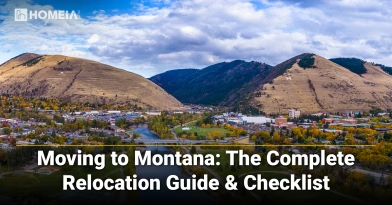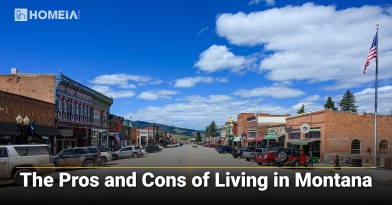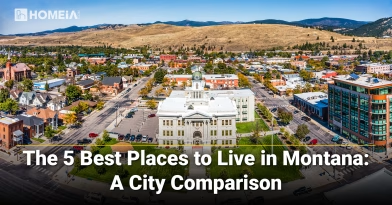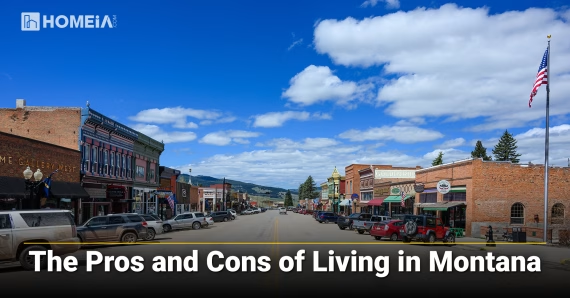7 Most Affordable Places to Live in Montana
- Local Editor:Local Editor: The HOMEiA Team
Published: Nov 18, 2025
- Category: City Living Guide
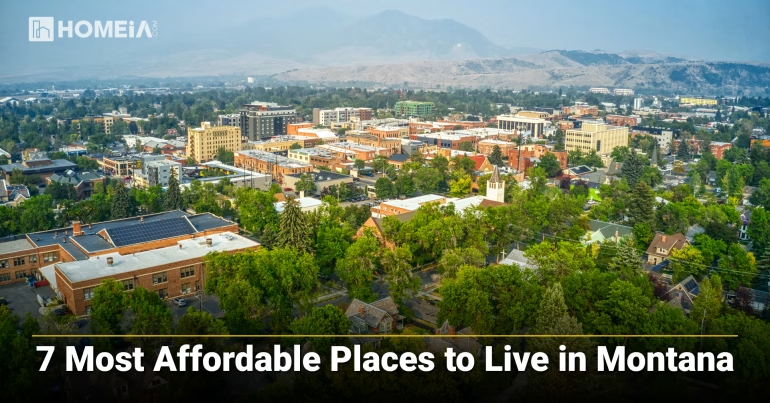
In a state known for breathtaking landscapes and rugged independence, Montana stands out for offering remarkable affordability amid natural splendor. With a median home price significantly below the national average and no state sales tax, Big Sky Country presents a compelling case for outdoor enthusiasts, remote workers, and families seeking a life rich in adventure, not expense. However, affordability varies widely throughout this portion of the Great Plains, and finding the right community is key to balancing budget with lifestyle.
Our guide moves past the postcard imagery to provide a detailed, data-driven analysis of the most affordable places to live in Montana for 2025. We’ve crunched the numbers on housing, utilities, transportation, and more to bring you seven communities where you can achieve financial stability without sacrificing the authentic experience. If you’re also considering other regions, you might find our guide on the most affordable places to live in Colorado helpful for comparison.
Table of Contents:
Key Takeaways
- Widespread Affordability: Montana’s overall cost of living is 5%-15% below the U.S. average, with many communities offering wallet-friendly housing, especially compared to neighboring Western states.
- Variety of Options: Affordable living isn’t limited to remote towns; it includes college towns, agricultural hubs, and communities with growing job markets, offering choices for every lifestyle.
- Trade-Offs Exist: The most affordable cities often come with trade-offs, notably fewer job opportunities outside key sectors, harsh winters, or more remote locations that require longer drives for major amenities.
- Beyond the Purchase Price: True affordability includes utility costs, which can be high in areas with extreme temperatures, and transportation expenses, which are substantial in isolated communities.
- Essential to Research: Safety and school ratings range from city to city, making it crucial to research specific neighborhoods rather than relying on statewide generalizations.
I. Methodology: How We Chose the Most Affordable Places
Our Methodologies to create HOMEiA Score Ratings for Each Group of Content
HOMEiA uses a consistent, data-driven methodology to evaluate U.S. states for livability, affordability, and long-term value. Drawing on data from sources such as the Census Bureau, BLS, Zillow, the Tax Foundation, and FBI crime statistics, this approach supports rankings on cost of living, relocation planning, pros and cons, and best places to live.
7 Montana Communities, One State: A Quick Comparison Table
City | HOMEiA Score | Cost of Living | Avg. Rent (2-Bed) | Home Price to Income Ratio | Income to Rent Ratio | Safety Rating |
|---|---|---|---|---|---|---|
| Kalispell | 78/100 | -5% | $1,250 | 5.5:1 | 59.8x | 71 |
| Bozeman | 80/100 | +2% | $1,500 | 6.1:1 | 65.5x | 74 |
| Missoula | 81/100 | -3% | $1,300 | 5.2:1 | 61.1x | 70 |
| Helena | 82/100 | -7% | $1,150 | 4.5:1 | 57.7x | 75 |
| Butte | 84/100 | -12% | $950 | 3.9:1 | 55.6x | 65 |
| Great Falls | 85/100 | -8% | $1,100 | 4.3:1 | 54.1x | 72 |
| Billings | 87/100 | -5% | $1,200 | 4.8:1 | 52.3x | 68 |
II. Detailed Community Analysis: Seven Affordable Enclaves
1. Kalispell: The Gateway to Glacier
HOMEiA Score: 78/100
- Cost of Living: 5% below U.S. average
- Monthly Rent: $1,250
- Home price to income ratio: 5.5:1
- Income to rent ratio: 59.8x
- Safety rating: 71/100
A. Cost of Living & Housing: Kalispell offers ideal value as the commercial hub of the northwest part of the state. It provides more affordable housing options than nearby resort communities while maintaining access to the region’s incredible natural amenities. Their cost structure supports comfortable living with premium outdoor access.
B. Economy & Job Market: Economic activity centers around healthcare, retail, and tourism-related services. As the largest city in the Flathead Valley, it serves as the commercial center for the region, providing stable employment across multiple sectors while benefiting from the tourism economy.
C. Access & Infrastructure: Glacier Park International Airport (FCA) and highway connections provide good accessibility. Comprehensive medical facilities through Kalispell Regional Healthcare, quality schools, and all essential services while serving as the gateway to Glacier National Park are all major pros.
D. Quality of Life & Culture: Life revolves around its proximity to Glacier National Park and Flathead Lake. Locals are offered a balance of small-town charm and essential amenities, with incredible outdoor recreation literally minutes away. Their safety rating and community atmosphere make it ideal for those seeking mountain living without resort prices. For those considering other mountain states, you might explore the most affordable places to live in Colorado.
Recommended for you
2. Bozeman: The Growing Mountain Town
HOMEiA Score: 80/100
- Cost of Living: 2% above U.S. average
- Monthly Rent: $1,500
- Home price to income ratio: 6.1:1
- Income to rent ratio: 65.5x
- Safety rating: 74/100
A. Cost of Living & Housing: Bozeman represents the premium end of Montana affordability, offering exceptional quality of life at rising costs. Its popularity has created a wave where standards have lifted, providing residents with world-class outdoor access and a thriving economy, despite a seismic increase in housing. Value comes in lifestyle rather than absolute affordability.
B. Economy & Job Market: Montana State University and a booming tech sector drive the economy. Healthcare, outdoor industry companies, and construction provide diverse employment opportunities in one of Montana’s fastest-growing and most economically vibrant communities.
C. Access & Infrastructure: Bozeman Yellowstone International Airport (BZN) offers seamless connectivity, while highway access provides a gateway to Yellowstone National Park. The city features top-tier medical facilities, quality schools, and comprehensive urban amenities that support its growing population.
D. Quality of Life & Culture: Life in The Valley of the Flowers centers around its incredible mountain setting and vibrant community. It offers immediate access to world-class skiing, fishing, and hiking, complemented by a sophisticated dining scene and cultural attractions. Its safety rating and community amenities make it ideal for those prioritizing lifestyle over absolute affordability.
3. Missoula: The University Town
HOMEiA Score: 81/100
- Cost of Living: 3% below U.S. average
- Monthly Rent: $1,300
- Home price to income ratio: 5.2:1
- Income to rent ratio: 61.1x
- Safety rating: 70/100
A. Cost of Living & Housing: While not exactly breaking the bank, Missoula offers the best value among Montana’s college towns. It hosts a vibrant cultural scene and outdoor access at prices that, while rising, remain below many Western college towns. The housing market offers good value for the quality of life.
B. Economy & Job Market: The University of Montana anchors the economy, providing consistent employment in education and healthcare. Tech companies, outdoor industry businesses, and healthcare providers round out a diverse employment base that supports the city’s educated workforce and creative economy.
C. Access & Infrastructure: Missoula International Airport (MSO) and major highway connections provide excellent accessibility. Garden City features comprehensive medical facilities through Providence St. Patrick Hospital, quality schools, and all urban amenities while maintaining its outdoor-oriented character.
D. Quality of Life & Culture: Their greatest asset is its combination of cultural richness and outdoor access. Here boasts a vibrant arts scene, excellent restaurants, and immediate access to rivers, trails, and wilderness areas. Its safety rating and community engagement are ideal for those seeking an active, educated community with Montana values.
Moving to Montana: The Complete Relocation Guide & Checklist
Bordered by Canada and five U.S. states, Montana offers vast wilderness, outdoor adventure, and a strong sense of community. Home to over a million residents, it combines scenic beauty with affordability, no sales tax, and independent spirit. This guide provides key insights for relocating to the breathtaking Treasure State.
4. Helena: The Capital City Value
HOMEiA Score: 82/100
- Cost of Living: 7% below U.S. average
- Monthly Rent: $1,150
- Home price to income ratio: 4.5:1
- Income to rent ratio: 57.7x
- Safety rating: 75/100
A. Cost of Living & Housing: Helena offers exceptional value as a state capital, with housing costs remaining reasonable despite its governmental importance. Here provides a range of housing options from historic Victorian homes to modern subdivisions, all at prices supporting comfortable living on public or private sector salaries.
B. Economy & Job Market: As the state capital, government employment provides economic opportunity, complemented by healthcare, education, and a growing technology sector. Carroll College and state agencies offer diverse career opportunities, while small businesses thrive in the supportive community environment.
C. Access & Infrastructure: Helena’s regional airport (HLN) and highway connections provide good accessibility. Boasting excellent healthcare facilities through St. Peter’s Health, quality schools, and all urban amenities while maintaining its small-city charm and outdoor accessibility.
D. Quality of Life & Culture: Life in Queen City has many believing they live in outdoor royalty. Revolving around its incredible outdoor setting between the Continental Divide and the Elkhorn Mountains makes it nearly impossible to spend time indoors. When looking to relax, the city features a vibrant downtown, numerous trails, and cultural attractions including the Montana Historical Society. An exceptional safety rating and family-friendly atmosphere make it ideal for those seeking capital city amenities with traditional affordability.
5. Butte: The Historic Mining Town
HOMEiA Score: 84/100
- Cost of Living: 12% below U.S. average
- Monthly Rent: $950
- Home price to income ratio: 3.9:1
- Income to rent ratio: 55.6x
- Safety rating: 65/100
A. Cost of Living & Housing: Butte represents one of the state’s most affordable homeownership markets. The Richest Hill on Earth offers historic homes at rock-bottom prices, with homeownership available under $200,000. Overall cost structure allows for extremely budget-conscious living while maintaining access to urban amenities.
B. Economy & Job Market: Economic diversity from its mining roots now includes healthcare, education, and tech. Montana Tech University provides consistent employment and educational opportunities, while healthcare and small business development contribute to economic stability in this resilient community.
C. Access & Infrastructure: Located at the intersection of I-90 and I-15, it serves as a major transportation crossroads. Possessing all essential services, including a regional hospital and reliable utilities. Its central location makes it accessible to both western and central destinations.
D. Quality of Life & Culture: This part of Big Sky Country’s rich history and unique character define daily life. Residents preserve its mining heritage while embracing outdoor recreation in the surrounding mountains. Community events, historic architecture, and a valued identity create a distinctive living experience. The safety rating reflects its working-class heritage and ongoing revitalization efforts.
The Pros and Cons of Living in Montana
Montana is more than its majestic mountains and wild beauty—it’s a state where adventure and community thrive. However, challenges like long winters, job scarcity, and isolation exist. This guide explores Montana’s pros and cons, plus its best cities for professionals, families, and retirees seeking life in Big Sky Country.
6. Great Falls: The Riverfront Value
HOMEiA Score: 85/100
- Cost of Living: 8% below U.S. average
- Monthly Rent: $1,100
- Home price to income ratio: 4.3:1
- Income to rent ratio: 54.1x
- Safety rating: 72/100
A. Cost of Living & Housing: Great Falls offers some of the best housing values in Montana’s larger cities. Affordable homeownership opportunities are plentiful within a stable real estate market. Utility costs are manageable, and the overall cost structure supports comfortable family living on moderate incomes.
B. Economy & Job Market: The economy centers around Malmstrom Air Force Base, healthcare, and agriculture. Doing so bolsters stability against economic fluctuations. The city serves as a regional medical hub with Benefis Health System, while manufacturing and retail round out the employment base.
C. Access & Infrastructure: Situated on the Missouri River with international airport (GTF) and major highway connections, Electric City is home to innovative infrastructure. The city has comprehensive medical facilities, quality schools, and all essential services while maintaining its affordable character.
D. Quality of Life & Culture: GF boasts incredible outdoor access with the Missouri River, Giant Springs, and numerous parks. The city features the C.M. Russell Museum, excellent fishing, and family-friendly amenities including a minor league baseball team (Voyagers). Its above-average safety rating and community-oriented atmosphere make it ideal for families and outdoor enthusiasts seeking affordability without isolation.
7. Billings: The Energy and Healthcare Hub
HOMEiA Score: 87/100
- Cost of Living: 5% below U.S. average
- Monthly Rent: $1,200
- Home price to income ratio: 4.8:1
- Income to rent ratio: 52.3x
- Safety rating: 68/100
A. Cost of Living & Housing: As Montana’s largest city, Billings offers the most robust economy with surprisingly affordable housing. Magic City hosts unbeatable value with a diverse housing stock with anything from historic homes to new construction, all at prices well below national averages. The cost of living allows for comfortable middle-class living.
B. Economy & Job Market: Deemed the economic engine of eastern MT, its strength lies in healthcare, energy, and transportation sectors. Major employers include Billings Clinic, St. Vincent Healthcare, and numerous energy companies. This position ensures stable employment opportunities across multiple industries.
C. Access & Infrastructure: With an international airport (BIL), major interstate access (I-90 and I-94), and comprehensive healthcare facilities, it offers full urban amenities. Also available are major retailers, standout schools, and reliable infrastructure residents and the surrounding agricultural region alike.
D. Quality of Life & Culture: Life balances urban convenience with outdoor accessibility. The Rimrocks provide stunning backdrop views, while nearby rivers and mountains offer endless recreation. There exists a vibrant downtown, minor league baseball, and cultural attractions including the Yellowstone Art Museum. Its safety rating reflects its status as a well-managed regional center.
The 5 Best Places to Live in Montana: A City Comparison (updated)
Montana blends rugged wilderness with welcoming communities, offering endless opportunities for outdoor living and growth. This guide spotlights the five best Montana cities to live in 2025, based on affordability, opportunity, safety, and quality of life—from vibrant Missoula to scenic Bozeman—helping you find your perfect Rocky Mountain home.
III. A Relocation Checklist for Your Montana Home
Budget for the True Cost: Account for utility costs, which can be exponential for heating during Montana’s long winters. Factor in transportation costs, especially when living in more remote areas or commuting between communities.
Secure Employment First: Job markets can be specialized in MT. Secure employment before moving, especially if you’re not in high-demand fields like healthcare, education, or skilled trades.
Visit in Person: If possible, visit your chosen community during different seasons. Its character changes dramatically from summer to winter, and you’ll want to experience both before committing.
Confirm Internet Reliability: For remote workers, this is essential. While larger towns have reliable service, confirm the provider and available speeds at your specific address before signing a lease or mortgage.
Prepare for Winter: Budget for winter clothing, vehicle preparation (snow tires, emergency kits), and higher heating costs. Montana winters are beautiful but require preparation and additional expenses.
Conclusion: Your Affordable Montana Future Awaits
From the energy hub of Billings to the mountain gateway of Kalispell, these seven communities prove that you can access the Montana dream without a premium price tag. Big Sky Country offers a unique opportunity to build a future where your spirit for adventure and independence is matched by the financial wisdom of your chosen home. By carefully considering what each of these affordable enclaves has to offer, you can find the perfect spot to plant your roots and thrive under the endless Big Sky. For those considering a different state, you might also explore the most affordable cities to live in Colorado.
Recommended for you
FAQs About the Most Affordable Places to Live in Montana
1. Is it possible to find a home under $300,000 in Montana? Yes, absolutely. Markets like Butte, Great Falls, and Billings regularly host numerous homes listed below $300,000. These may be older homes or require renovations, but they represent excellent value in today’s market.
2. What is the biggest hidden cost of moving to Montana? Winter expenses and transportation. Heating costs during the state’s unforgiving winters can be substantial. In more remote communities, vehicle maintenance, snow tires, and longer drives for shopping or healthcare can become significant monthly expenses.
3. Are these communities good for remote workers? It varies. Developed towns including Billings, Missoula, and Bozeman have multiple providers with reliable high-speed internet. More remote communities may have limited options. It’s essential to confirm reliable internet availability at your specific address before moving.
4. What is the property tax situation like? Here has relatively moderate property tax rates compared to the national average. There are also favorable tax provisions for agricultural land and primary residences, which can reduce the tax burden for eligible residents.
5. How do I choose between these cities? Prioritize your needs.
For Jobs: Look at Billings or Missoula for the most diverse employment opportunities.
For Lowest Cost: Consider Butte or Great Falls for the most budget-friendly options.
For Families: Helena and Billings offer excellent schools and community amenities.
For Retirees: Great Falls and Kalispell provide great value and access to healthcare.
For Outdoor Access: Missoula, Bozeman, and Kalispell offer premium mountain and recreational access.
Always research specific neighborhoods within these cities, as conditions can vary dramatically from one area to another.
HOMEiA is a city guide site where visitors can find detailed information about communities of interest. HOMEiA’s City Guides, created in partnership with local writers and editors, are curated lists of the best, safest, and most affordable places to live. The guides feature the HOMEiA Score, a proprietary index that rates communities on such factors as housing costs, education, employment, etc.
HOMEiA.com aims to be the premier site for people planning to relocate, providing them with insightful content and connecting them with skilled real estate professionals.
We also empower real estate professionals to establish or strengthen their web presence by highlighting their experience, knowledge and achievements. If you’re selected to join our list of certified real estate professionals, you will distinguish yourself from your peers — and earn HOMEiA’s support.
If you believe in HOMEiA’s mission, please share our website with others.






